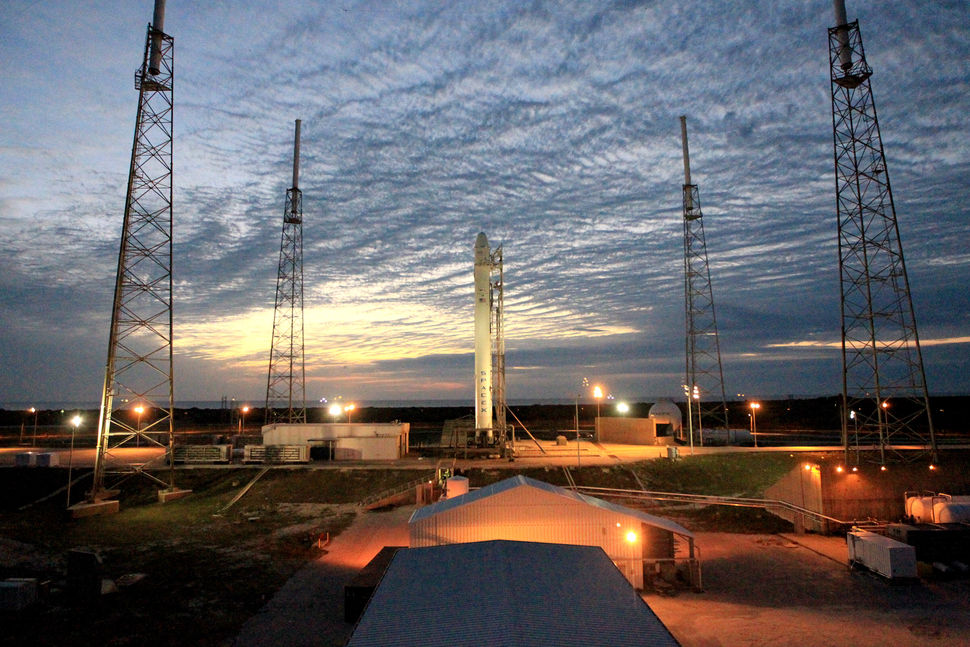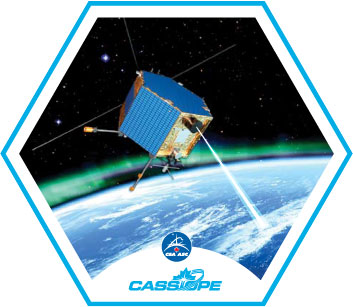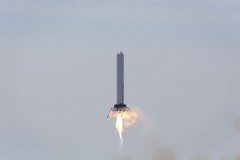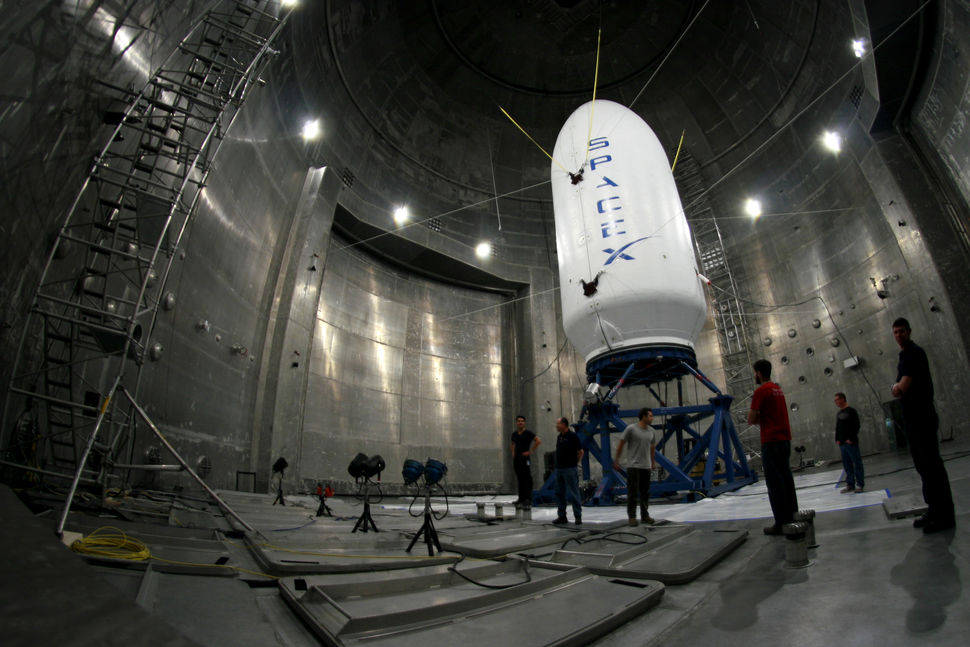
Like a row of pearls, SpaceX—the Hawthorne, Calif.-based launch services organization and seemingly “golden child” of NASA’s Commercial Crew integrated Capability (CCiCap) aspirations—plans to line up the records to be broken with the scheduled maiden voyage of its Falcon 9 v1.1 rocket. Originally targeted for Sunday, 15 September, the mission was postponed by two weeks, apparently due to issues which arose following a “hot-fire” test of the rocket on Thursday, 12 September. A second hot fire was successfully concluded on Thursday, 19 September, positioning SpaceX to attempt a launch on Sunday, 29 September. The mission will be SpaceX’s first flight from Space Launch Complex (SLC)-4 East at Vandenberg Air Force Base, Calif., and the first Falcon 9 to launch over the Pacific Ocean. It will also trial the uprated Merlin-1D engines for the first time, will attempt a risky propulsive-return-over-water test after first-stage separation, and will showcase a payload fairing to encapsulate its primary cargo: Canada’s 800-pound CASSIOPE communications and science satellite.
CASSIOPE was developed by the Canadian Space Agency (CSA), with project leadership from the University of Calgary’s Institute for Space Research. It carries the Cascade communications system and the enhanced Polar Outflow Probe (ePOP) science experiment. Together, these have produced the impressive “CASSIOPE” acronym, which stands for “Cascade, SmallSat, and IOnospheric Polar Explorer.” The hexagonal satellite measures 71 inches corner-to-corner and about 50 inches tall and will be injected into a highly-elliptical low-Earth orbit.Once there, ePOP will gather data on the impact of solar storms on Earth’s atmosphere, which trigger polar aurorae at high northern latitudes and are known to have detrimental effects upon satellites and ground-based systems. To do this, it carries a battery of eight scientific instruments, including plasma imagers, radio wave receivers, magnetometers, and cameras.

Meanwhile, Cascade will provide a secure digital store-and-forward service, delivering files within 90 minutes and having a storage capacity of 50-500 gigabytes. “Like a courier in the sky,” explained CSA, “Cascade’s operational concept is to pick up large digital data files and deliver them to almost any destination in the world. The concept supports the efficient transfer of these files, equivalent to 50-500 pickup trucks filled with paper.”
The long-awaited “Flight Six” of the Falcon 9 marks a clear break with convention. For starters, the five previous Falcon 9 missions have all flown from Space Launch Complex (SLC)-40 at Cape Canaveral Air Force Station, Fla., delivering either full-scale test articles into orbit or actual Dragon cargo capsules to the International Space Station. Under the provisions of a $1.6 billion Commercial Resupply Services (CRS) contract with NASA, signed in December 2008, SpaceX is committed to staging a series of at least 12 Dragon cargo missions to the ISS by 2016. The company is also a leading contender to return U.S. astronauts to space from U.S. soil, later this decade. Additionally, SpaceX possesses a healthy list of future commercial customers, including Israel’s AMOS-6 communications satellite, Canada’s three-satellite RADARSAT Constellation Mission, and Germany’s second-generation SARah radar-reconnaissance satellite network.

The Falcon 9 v1.1 mission with CASSIOPE marks the end of an eight-year hiatus in flights from SLC-4 East, whose mountain-ringed Vandenberg setting reverberated to the sound of 68 launches over four decades. Originally known as “PALC2-4,” it formed one of two complexes dedicated to Atlas-Agena launches and first supported the flight of a KH-7 reconnaissance satellite in August 1964. A total of 27 Atlas-Agenas flew from PALC2-4, until the pad was deactivated for the first time in June 1967. Four years later, it entered service as the upgraded complex for the Titan IIID rocket, which flew 22 times from the newly renamed SLC-4 East between June 1971 and November 1982. Its next resident was the Titan 34D, which flew seven missions between June 1983 and November 1988. These flights included an ill-fated launch in April 1986—just three months after the Challenger disaster—which exploded nine seconds after liftoff.
Most recently, SLC-4 East was employed by the final generation of Titan rockets—the Titan IV—and staged 12 missions between March 1991 and October 2005, the last of which placed the classified NROL-20 payload into orbit for the National Reconnaissance Office. This brought SLC-4 East’s tally up to 68 total launches, of which Sunday’s long-awaited flight of the Falcon 9 v1.1 and CASSIOPE will represent the 69th. The complex was extensively upgraded by SpaceX in 2011-2013. Last November, Space News reported that SpaceX had spent up to $30 million to remove mobile servicing and umbilical towers—including a giant hammerhead crane—from SLC-4 East and construct a 30,000-square-foot integration and processing hangar, whilst retaining an existing concrete pad and flame trench.
The two-stage Falcon 9 v1.1 will showcase SpaceX’s uprated Merlin-1D rocket engines, which will generate about 56 percent increased thrust at sea level than their Merlin-1C predecessors on the earlier v1.0. The engines are fueled by a mix of liquid oxygen and a form of rocket-grade kerosene, known as “RP-1,” and the 227-foot-tall Falcon 9 v1.1 vehicle can power payloads weighing up to 29,000 pounds into low-Earth orbit or up to 10,700 pounds into geostationary transfer orbit.
At the “business end” of the v1.1’s first stage, the Merlin-1Ds are configured in an octagonal pattern, with a circle of eight engines and a ninth in the center. This is somewhat different from the “tic-tac-toe” layout of the Merlin-1C engines on the v1.0. The first stage itself is also significantly longer than its predecessor, to account for the larger propellant tanks. When the liftoff command is issued, the first stage engines will generate 1.3 million pounds of thrust—about 200,000 pounds greater than the v1.0—and will push the vehicle uphill for 180 seconds, their propulsive yield gradually rising to 1.5 million pounds in the rarefied high atmosphere. “Unlike airplanes, a rocket’s thrust actually increases with altitude,” noted SpaceX. “Falcon 9 generates 1.3 million pounds of thrust at sea level, but gets up to 1.5 million pounds of thrust in the vacuum of space. The first-stage engines are gradually throttled near the end of first-stage flight to limit launch vehicle acceleration as the rocket’s mass decelerates with the burning of fuel.”
With around 1,970 seconds of test time and a lengthy qualification program, SpaceX has expressed supreme confidence in the Merlin-1D. During a full-duration-mission firing in June 2012 in McGregor, Texas, the engine operated at or above the power (147,000 pounds of thrust) and duration (185 seconds) required for a Falcon 9 launch. The Merlin-1D has a vacuum thrust-to-weight ratio in excess of 150:1, making it the most efficient liquid-fueled rocket engine in history.

Its propulsive output represents a marked increase over the 1.1 million pounds of thrust produced by the Merlin-1C-equipped v1.0 at launch. For future Dragon missions, this is expected to enable SpaceX to utilize virtually all of the cargo craft’s payload capacity. The ignition system for the v1.1’s first stage was tested in April 2013.
On Thursday, 12 September, SpaceX CEO Elon Musk tweeted that the Falcon 9 v1.1 hot-fire test—a static test firing of the nine Merlin-1D engines on the rocket’s first stage—was about to commence. As noted by NASASpaceflight.com, two aborts were experienced during the procedure, ahead of a successful hot-fire on the third attempt. The test evaluated the performance of SLC-4 East’s fueling equipment and demonstrated the nominal start-up capability of the nine Merlin-1D engines. According to a tweet by Musk, the test successfully executed a 2-second static test firing, but uncovered “some anomalies to be investigated”. This led to a launch postponement, initially reported to be in the range of 1-2 weeks. The success of the second hot fire test on 19 September was highlighted in a follow-up tweet by Musk, which noted that SpaceX had “completed rocket static fire with all systems green this time…Launch window opens in 10 days”.
The Merlin-1D-equipped first stage also includes four extendible landing legs—manufactured from carbon-fiber and aluminum honeycomb—to support a series of tests which Musk hopes will lead to vertical-takeoff-vertical-landing (VTVL) capability by the latter half of the present decade. The first launch will attempt a propulsive water landing in the Pacific Ocean.”The initial recovery attempts will be from a water landing,” Musk explained after the CRS-2 Dragon splashdown in March 2013. “The first-stage booster will, after separation, continue in a ballistic arc and execute a velocity-reduction burn in the atmosphere to lessen the impact.” This burn should slow the first stage from about Mach 10 (7,600 mph) to a more controllable descent velocity, after which a second burn will occur just before it impacts the Pacific Ocean to simulate a vertical landing. “I want to emphasize that we don’t expect success in the first several attempts,” Musk cautioned. “Hopefully, next year, with a lot more experience and data, we should be able to return the first stage to the launch site, deploy its landing legs, and then do a propulsive landing on land back at the launch site. This year, our efforts will be focused on recovering the first stage … from an ocean landing, and then next year it will be about the return to launch site with the landing gear deployed.”

This will be the first high-altitude, high-velocity test of SpaceX’s strategy to ultimately bring both the first and second stages of the Falcon 9 v1.1 back to the launch site for refurbishment and reuse. It is Musk’s expectation that these attempts will continue on each Falcon 9 mission until a successful return-to-launch-site is achieved. Last month, the company’s Grasshopper VTVL technology demonstrator ascended to an altitude of about 820 feet and conducted a 330-foot lateral (horizontal) maneuver, before alighting back onto its launch pad. Earlier this summer, a Grasshopper rose to a record altitude of 1,066 feet above SpaceX’s test facility in McGregor, Texas, and landed safely.
With the nine Merlin-1Ds of the first stage having completed their role and separated, the turn will come of the second stage, which is powered by a single Merlin-1D Vacuum engine. This will burn for about 345 seconds, with a thrust of 180,000 pounds, to insert CASSIOPE into its highly-elliptical low-Earth orbit. The stage is supplemented by four Draco reaction-control thrusters to provide stable attitude conditions for the separation of the payload. Sunday’s mission also marks the first to demonstrate a 43-foot-long jettisonable payload fairing. Since previous Falcon 9 missions carried Dragon capsules or boilerplates, payload fairings were unnecessary, but are needed in order to protect CASSIOPE during ascent. SpaceX has extensively tested the fairing in the Reverberant Acoustic Test Facility at NASA’s Plum Brook Station in Sandusky, Ohio, part of the space agency’s Cleveland-based Glenn Research Center.
SpaceX did not host media for this launch, nor did they allow remote cameras to be set up at SLC-4 East. Instead the U.S. Air Force hosted the media and conducted remote camera setup outside SpaceX’s area of control. This is in stark contrast to how every other launch in the continental United States is conducted by every other launch service provider currently in existence.
Want to keep up-to-date with all things space? Be sure to “Like” AmericaSpace on Facebook and follow us on Twitter: @AmericaSpace
Missions » CASSIOPE »




Excellent article!
Just want to emphasize three points:
1. The static test anomalies invoved the Ground Support Equipment, not the Falcon 9 v1.1.
2. MDA dictates the media hosting, not SpaceX.
3. This is a test launch, so let’s have high hopes and low expectations 🙂
This article is by far one of the best pieces of work that I’ve seen on AmericaSpace!!! AWESOME!
Thanks for the updates, Lori. It certainly will be an impressive, ambitious and historic launch for all involved.
Best wishes,
Ben
I think that the M1D is the most efficient liquid fuelled engine if you don’t include staged combustion engines but I might be wrong. Also didn’t know that there were Dracos on the 2nd stage? Are you sure? I know there was talk about putting them in the F9R 1st stage but 2nd? If you could clarify that would be great and if that’s correct then this is turning out to be one hell of a test flight.
Great article btw.
Also no legs this flight.
Yes, no legs on this one.
Hee hee! I riDES THEm EorROCKETS steaRIGHT to the MOOOOOOOOOOON!
Everything SpaceX does is impressive.
I hope there will also be a video of the attempted vertical landing in the ocean. Even as the first attempt, I am sure that will be impressive.
The grasshopper tests are impressive by themselves.
All the best and safe flight. I know I will be monitoring it on Sunday. Makes you feel like a kid just watching it every time.
JBD